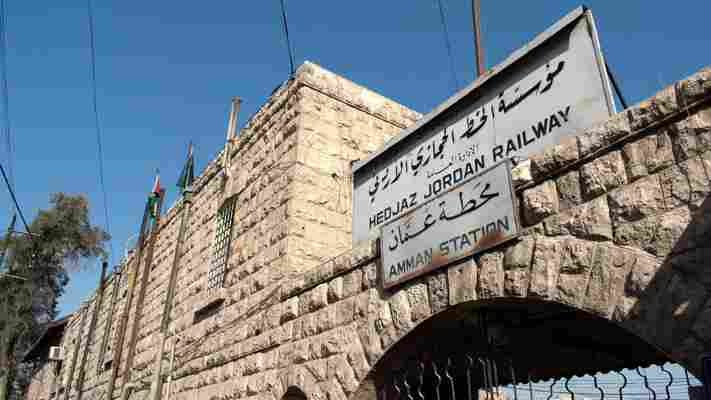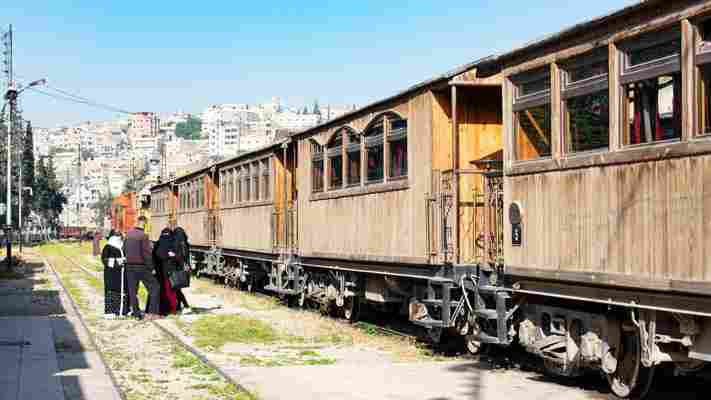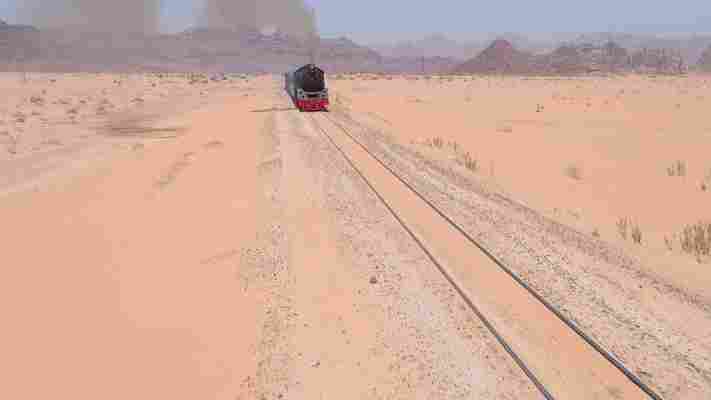Article continues below

Amman’s Hejaz Railway station is easy to miss (Credit: Amanda Ruggeri)
Located on the side of a dusty road, Amman’s Hejaz Railway station is easy to miss. To get there, you must leave the labyrinthine streets that spiral through the city’s historical centre, swirling up hills and eddying around better-known sites like the ancient citadel or Roman theatre. The drive out to the station is about 5km; when there is traffic, as there often is in Jordan’s capital, it can feel longer.
Step through the stone gate, though, and it feels like you’ve entered a different era. Here, steam locomotives are still king. The Ottoman sultan controls a swath of land from modern-day Bosnia-Herzegovina to the Black Sea and Basra to Beirut.
And hopes are high that a railway can unite the Muslim world.

The Hejaz Railway was ordered by Sultan Abdul Hamid II in 1900 (Credit: Amanda Ruggeri)
Ordered by Sultan Abdul Hamid II in 1900, the Hejaz Railway was constructed to make it easier and safer to reach Mecca during hajj , the pilgrimage Muslims are expected to make at least once in a lifetime. Previously, pilgrims travelled for weeks, if not months, by camel caravan. The section from Damascus to Medina alone took 40 days, and many pilgrims died en route in the dry deserts and harsh mountains. The railway shortened the 40-day journey to five.
After the Damascus-Medina section finished, the plan was to extend the line north to the Ottoman capital of Constantinople and south to Mecca itself.
But the railway’s importance to Islam didn’t end there. Unusually for a transportation project at the time, it was financed entirely by donations from Muslims, Ottoman state revenues and taxes – and without any foreign investment. As a result, even today, the route is considered waqf : an asset that belongs to all Muslims. “It is not owned by a country. It’s not owned by any one person. It’s owned by all the Muslims in the world,” said Azmi Nalshik, director general of Jordan Hejaz Railways. “It’s like a mosque: it can’t be sold.”

“Any Muslim in the world... can come and claim, ‘I have shares in this’” (Credit: The Travel Show)
Any Muslim in the world – even from Indonesia or Malaysia – can come and claim, ‘I have shares in this’,” Nalshik said.
In 1908, the first train ran from Damascus to Medina (Credit: Amanda Ruggeri)
For Sultan Abdul Hamid II, uniting the Muslim world wasn’t just a spiritual imperative: it had pragmatic benefits. Over the last few decades before the railway was built, rival empires had nibbled away at Ottoman territory. The French had taken Tunisia; the British invaded Egypt; Romania, Serbia and Montenegro gained independence. By connecting people from across the Ottoman world, the sultan wanted to unite not only Muslims – but his empire.
It didn’t exactly turn out that way. In 1908, the first train ran from Damascus to Medina. The next year, the sultan was overthrown.
One car is lovingly restored in early 20th-Century style (Credit: Amanda Ruggeri)
Today, the Ottoman Empire is a memory. So is the lack of borders that once characterised the route, which now runs through five nations (Turkey, Syria, Jordan, Israel and Saudi Arabia. Despite carrying 300,000 passengers a year by 1914, the Hejaz Railway’s heyday would last only a decade. After the Turkish army began to use it in World War I, conflict cut up the line; it was attacked by British officer TE Lawrence , nicknamed Lawrence of Arabia, and other soldiers in the Arab Revolt. After the war, when the British and French carved up the Levant between them, maintaining a railway that united Muslims was anything but a priority. Most of the line fell into disrepair.
Today, steam locomotives stand idle at the railway’s main station in Amman, colourful but quiet. A one-room museum showcases the century-old flotsam and jetsam of the once-popular line: old tickets and photographs, lanterns and railway ties. One car, lovingly restored in early 20th-Century style – plush velvet chairs, gilded lamps – gives a sense of the era’s optimistic opulence.
“The story of the Hejaz Railway is a literal tragedy,” wrote scholar Sheikh Ali Attanttawi after the line had fallen largely defunct. “The line is there, but no train in motion… the stations exist, but with no passengers.”
This is not simply a story of dashed hopes and neglect (Credit: Amanda Ruggeri)
But this is not simply a story of dashed hopes and neglect.
In Jordan, two parts of the line are accessible to the public today (Credit: Amanda Ruggeri)
Over the years, some of sections have been revived, if piecemeal. Israel opened a re-built section from Haifa to Beit She’an in 2016. The line from Amman to Damascus ran as late as 2011 – so popular that several locals said, wistfully, how they used to enjoy taking it for weekend outings to Syria.
And in Jordan, two parts of the line are accessible to the public today. There is a summer-only steam locomotive, primarily for tourists, which runs through the desert in Wadi Rum – the same line that Lawrence of Arabia once attacked. And there is a weekly train that operates year-round from Amman to Al-Jizah station, used mostly by locals for leisure outings.
And so, on a recent Saturday morning, Amman’s Hejaz Railway station bustled with families. Women in bright headscarves carried enormous bags of food. Children toted footballs and toys. We were taking the train from Amman to Al-Jizah: a 35km journey south that, on the narrow-gauge track where trains are allowed to go a maximum of 15km per hour, would take two hours.
The journey was the point for travellers (Credit: Amanda Ruggeri)
But the journey was the point.
As the train pulled out of the station, children squealed (Credit: Amanda Ruggeri)
As the train pulled out of the station, children squealed. Crowding into each carriage’s outdoor cab, they hung over the railings, pointing as the city rattled by. As we crawled through Amman’s outskirts, the landscape wasn’t particularly picturesque. Incongruously, the historical track sometimes ran alongside, or over, a modern road; at one intersection we chugged past parked cars, a pick-up truck laden with boxes of fruit and roosters scrabbling for food on the pavement.
An old man and his grandson peeked at us through a hole in a wall. Small children ran up to the train, throwing plastic cups at us in their own game of Arab revolutionaries against the Hejaz. One, overcome by the noise, stopped still and put her hands over her ears.
It didn’t matter: the children on the train were entranced. Many of them, I found out, were children from Amman, excited to see their city in such a different way. And one small group – beaming the same big smiles as the others – were Syrian refugees.
For all of them, the Hejaz Railway was an adventure (Credit: Amanda Ruggeri)
For all of them, the Hejaz Railway was an adventure.
Women were standing in the aisles, dancing (Credit: Amanda Ruggeri)
Inside, meanwhile, the party was heating up. The women turned music up, loud, on small stereos they’d brought with them.
When I passed through one carriage, the women were standing in the aisles, dancing; they dissolved with embarrassed laughter when I entered, and shook their heads, still chuckling, when I asked if I could take their picture.
Today, the track is mostly used for leisure, tourism, fun (Credit: Amanda Ruggeri)
Two hours later, pulling up to Al-Jizah station, everyone piled out, heading for tables in the shade of the olive trees. Jugs of tea came out; so did za’atar-topped manakish (a pizza-like flatbread), mo’ajanat (fried, rolled savoury pastries) and falafel. Around the back of the station, the older kids puffed on a hookah they’d brought for the occasion.
This is what the track is mostly used for today: leisure, tourism, fun.
There are hopes that, as in its heyday, the Hejaz Railway could be something more (Credit: The Travel Show)
But there are hopes that, as in its heyday, the Hejaz Railway could be something more.
Some hope to introduce more people to the history of the Hejaz Railway (Credit: Amanda Ruggeri)
First, there is its practical potential: 600,000 people make the 30km commute from Zarqa to Amman each day, Nalshik said, but there is little public transport. A feasibility study is being done to see if rehabilitating the Hejaz Railway between these two cities could help with traffic.
Another ambition is more outward-focussed: to introduce more people to the history of the Hejaz Railway. “So many people pass by and don’t know this station exists, and that it’s been in operation for 110 years,” Nalshik said. “I’m working to help put it on the tourism map for Jordan.”
One goal is to have the railway inscribed on the Unesco World Heritage list (Credit: Amanda Ruggeri)
One goal is to have the railway inscribed on the Unesco World Heritage list ; Saudi Arabia submitted it for consideration in 2015 (the country hasn’t revived the line for actual transport like Jordan has, but it has a small museum and considers the railway part of its heritage, too). In Amman, a new museum is being built at the station, a contemporary 3,000 sq m construction expected to be finished by the end of 2018. In a symbolic twist, the museum is being funded by the Turkish Development Agency (TIKA).
It seems hard to imagine a time when the train will again carry travellers from Syria to Saudi Arabia. But as long as the heritage of the Hejaz Railway is kept alive – and recognised – both the hope, and the potential, will endure.
